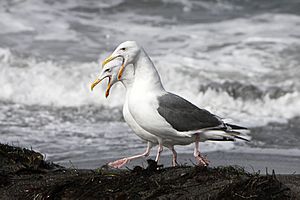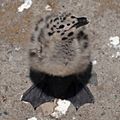Western gull facts for kids
Quick facts for kids Western gull |
|
|---|---|
 |
|
| Adult | |
 |
|
| 1st winter juvenile | |
| Conservation status | |
| Scientific classification | |
| Genus: |
Larus
|
| Species: |
occidentalis
|
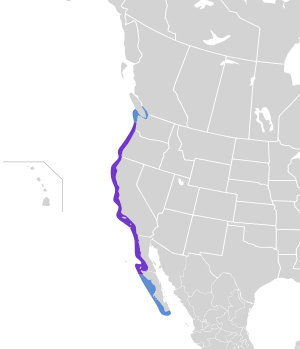 |
|
The western gull (Larus occidentalis) is a large gull that lives along the west coast of North America. You can find them from British Columbia, Canada, all the way down to Baja California, Mexico. These birds were once thought to be the same species as the yellow-footed gull (Larus livens), which lives in the Gulf of California.
Contents
About the Western Gull
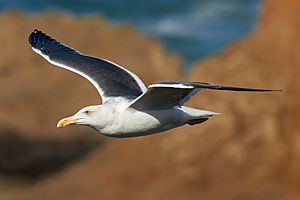
The western gull is a big bird! It can be about 55 to 68 cm (22 to 27 in) long. Its wings can spread out to 130 to 144 cm (51 to 57 in) wide. These gulls usually weigh between 800 to 1,400 g (1.8 to 3.1 lb).
Western gulls have a white head and body. Their wings are gray. They have a bright yellow beak with a small red spot near the tip. This red spot is important! Baby gulls peck at it to tell their parents they are hungry.
It takes about four years for a western gull to get its full adult feathers, also called its plumage. These gulls usually live for about 15 years. Some can even live up to 25 years! The biggest group of western gulls lives on the Farallon Islands. These islands are about 26 mi (40 km) west of San Francisco, California. About 30,000 gulls live in the San Francisco Bay Area. You can also find many western gulls along the Oregon Coast.
Where Western Gulls Live
Western gulls live all year round in California, Oregon, Baja California, and southern Washington. Some gulls travel north to northern Washington and British Columbia. Others go south to Baja California Sur during the non-breeding season. They almost always stay near the ocean. They rarely go more than 100 miles inland.
Western Gull Behavior
Western gulls build their nests on islands and rocks along the coast. They also nest on islands inside estuaries, which are places where rivers meet the sea. You can find colonies on Año Nuevo Island, Anacapa Island in Channel Islands National Park, and Alcatraz Island in San Francisco Bay.
In these nesting areas, male and female gulls form long-term pairs. They fiercely protect their nesting spots. These areas might change a little each year. But the gulls keep defending them for their whole lives.
How Western Gulls Find Food
Western gulls find food both in the open ocean and along the shore. In the ocean, they eat fish and small sea creatures. These include krill, squid, and jellyfish. They can't dive deep, so they only eat food floating on the water's surface.
On land, they eat dead animals like seals, sea lions, and roadkill. They also find cockles, starfish, limpets, and snails in tide pools. Western gulls are also known to eat human food. They will look for food at landfills, beaches, and parks. They might even steal food from people!
These gulls can be quite bold. They sometimes hunt and eat the young of other birds, like ducklings. They might even catch smaller adult birds. Some western gulls are known for eating pigeons. They will also snatch fish right out of a cormorant's or pelican's mouth!
Life Cycle of Western Gulls
Reproduction
Western gulls build a nest out of plants within their protected territory. The female usually lays three eggs. Both parents take turns sitting on the eggs for about a month. Once the chicks hatch, they stay safely inside their parents' territory. If a chick wanders into another gull pair's territory, it might be attacked. Sadly, many chicks don't survive. On average, only one chick from each nest makes it to the age where it can fly. Sometimes, if chicks are left alone, other gulls might adopt them.
Hybridization
In Washington state, western gulls sometimes breed with glaucous-winged gulls. This creates hybrid gulls, which are a mix of both species. These hybrid gulls can look a bit like a Thayer's gull. However, hybrids usually have a flatter, larger head and a thicker beak. Their beak also has a more noticeable angle on the bottom part. This helps tell them apart from the smaller Thayer's gull.
Western Gulls and People
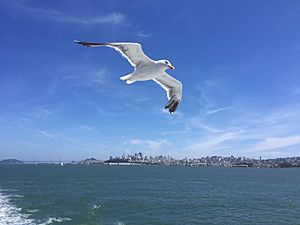
Today, the western gull is not considered an endangered species. However, they only live in a specific area. In the 1800s, their numbers dropped a lot. People collected their eggs to sell in the growing city of San Francisco. Also, their nesting areas were disturbed when they were turned into lighthouse stations or prisons, like Alcatraz.
Western gulls are very protective of their territories. Because of this, some people used to see them as a problem. But when lighthouses became automated and Alcatraz Prison closed, the gulls were able to return to many of their old nesting spots. Now, they are mostly at risk from things like El Niño weather events and oil spills.
Thousands of western gulls and their chicks live on Anacapa Island in Channel Islands National Park.
Western gulls have become a bit of a problem for the San Francisco Giants baseball team. Thousands of gulls fly over Oracle Park in San Francisco during the end of games. They fly onto the field and even poop on fans! After games, they eat leftover food in the seats. No one knows how the birds know when the game is about to end. A red-tailed hawk visited the park in 2011 and scared the gulls away. But they came back after the hawk left. It's against federal law to shoot the birds. Hiring a falconer to scare them away would cost the Giants a lot of money.
Western Gulls in Movies
The western gull was one of the main bird characters in Alfred Hitchcock's famous movie The Birds. This movie was filmed in Bodega Bay, California.
Gallery
-
A western gull chick on Alcatraz Island
-
A Western Gull eating a starfish
-
A pair of Western Gulls at Point Lobos
See also
 In Spanish: Gaviota occidental para niños
In Spanish: Gaviota occidental para niños



